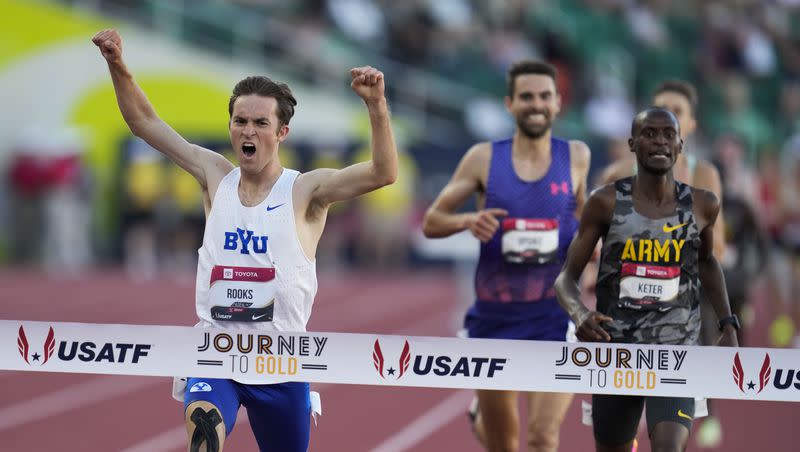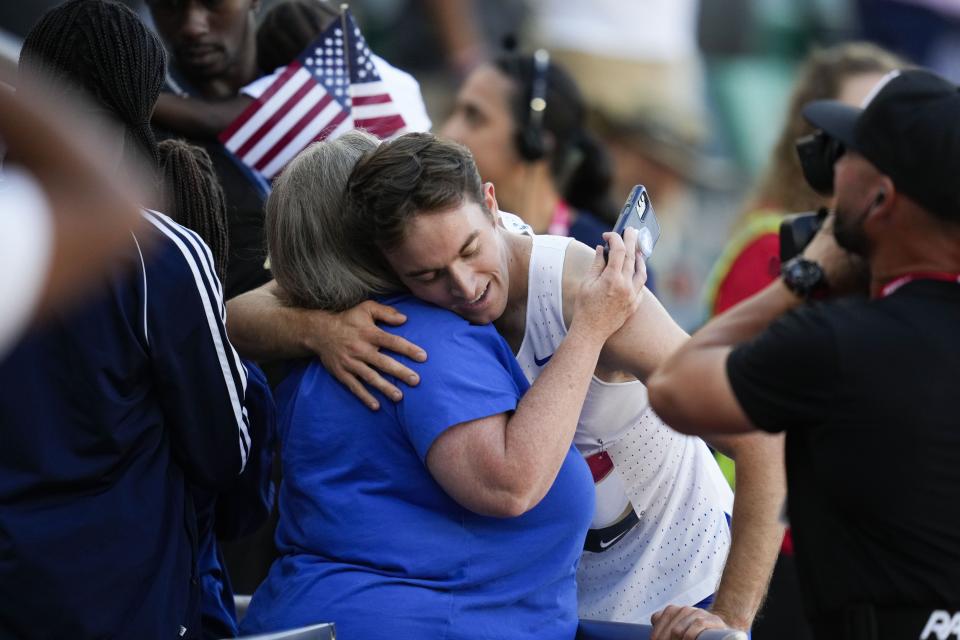BYU’s Kenneth Rooks wins 3,000-meter steeplechase at USA Outdoor Track and Field Championships

Even on a day when superstar Sydney McLaughlin was burning up the track again, BYU’s Kenneth Rooks delivered the most stunning performance on Day 3 of the USA Outdoor Track and Field Championships. Rooks won the 3,000-meter steeplechase — after falling.
Some 800 meters into the race (or two laps into the seven-and-a-half lap race), there was a traffic jam leading into the barrier. Rooks, with no room in the crowd to hurdle the heavy wooden obstacle, somersaulted over it instead and then rolled twice on the track as four trailing runners leaped over him.
As Rooks explained afterward, “Anthony (Rotich) stuttered in front of me, and I almost ran into him and I ran into the barrier. Everyone was running over the top of me. I got up and I just told myself I need to go into Henry Marsh mode.”
Marsh, a former BYU athlete and four-time Olympian, was famous for running at the back of the pack and working his way into the lead late in the race. “Interestingly, before the race, (falling) is a scenario I went through — what would I do if I fell,” Rooks told NBC afterward. Rooks decided that if he ever fell, he would work his way back to the pack gradually, which uses less energy than a burst of speed.
In the 14-man field, Rooks fell three seconds behind the 13th-place runner and four seconds behind the leader, and then began gradually closing the gap. After two laps, he had worked his way back to the pack and was only one second behind the leader and was still picking off rival runners one by one.
Related
Lee Diffey, the verbose, gushy NBC announcer, failed to even notice that Rooks had rejoined the three frontrunners with about 300 meters to go until sidekick Kara Goucher exclaimed, “Look at this! … Kenneth Rooks, the NCAA champion who fell and got back up and reattached himself to the pack, is now making a run for the national championship!”
As Eyestone explained later, it was one thing to catch the leaders again after spotting them a four-second lead during the race; it was quite another to be able to summon a kick after such an effort. But that was exactly what Rooks did. He moved into second briefly on the final turn, then fell back to fourth place, but as the group came off the water jump he made another move that carried him into second place. In the homestretch he hurdled the final barrier and sprinted into the lead as the crowd, fully aware of what was happening, roared.
“Wow, what a story this is!” said Diffey, never at a loss for words. “From falling to the finish and a national championship!” Goucher said, “What a race! You couldn’t have scripted that better.” Well, other than not falling.
Said Eyestone, “That was a testament of patience. That was like (the movie) ‘Chariots of Fire,’ where the guy falls and wins and you think, OK, that’s a little too much. It was Hollywood.”
Remarkably, despite the fall, Rooks, who concluded his junior season by winning the NCAA championships last month, recorded the fastest time of his three-year steeplechase career, 8:16.78. Bernard Peter was second in 8:17.19 and Isaac Updike third in 8:17.6.
The top three finishers in each event will represent the U.S. in the world championships in Budapest next month. No American steeplechaser has met the world championships qualifying mark of 8:15.00, but Eyestone said Rooks is a virtual lock to be accepted into the competition.
“If not, we’ll find him a race and get a qualifying time,” said the coach.
BYU coaches could not remember when (or even if) a BYU athlete had ever won a U.S. championship while still a collegiate athlete. It happened 52 years ago. Ralph Mann won the 440-yard intermediate hurdles in the 1971 U.S. championships as a BYU senior. A year later he won the silver medal in the Olympic Games.
What was Eyestone’s reaction when he saw Rooks fall?
“Initially, honestly, I was thinking, well, he’s had a good season, and there’s the Olympic trials next year. I just knew at this level of competition, if you’ve fallen and you’re four or five seconds back, the odds of him making the world championships team went from 95 percent to 5 percent or less.
“When he fell, I just slumped in my chair. I thought, well, let’s be patient and close the gap and beat some of these guys and maybe finish in the top 10. But each lap he got a little closer to the pack and then caught them.”
Eyestone added with a laugh, “Two weeks ago, he fell over the same barrier in a workout and did a barrel roll. That was a higher power probably preparing him for the race.”
As Eyestone was talking, Rooks approached him after completing a (long) victory lap. He told his coach, “Every single person wanted to take a picture of me!”
He was the story of the night.
“When he made the NCAA final as a freshman, we had a running joke going called the legend of Kenneth Rooks,” says Eyestone. “Well, I don’t know if he can top this unless he makes the world championships final. He’s got a good chance to do that — if he stays on his feet.”


